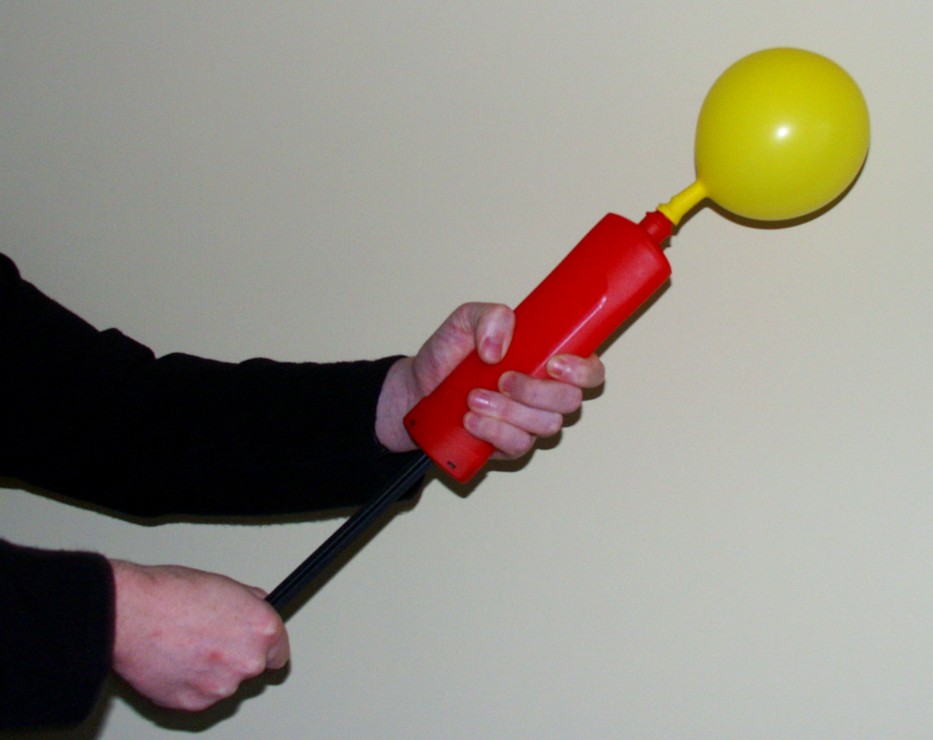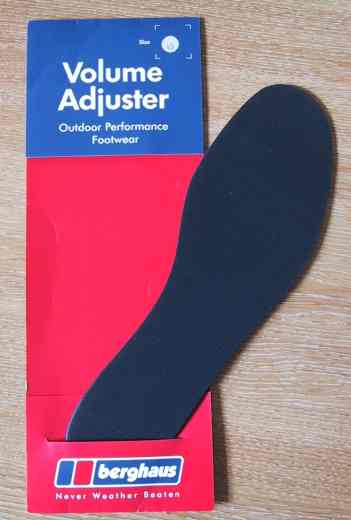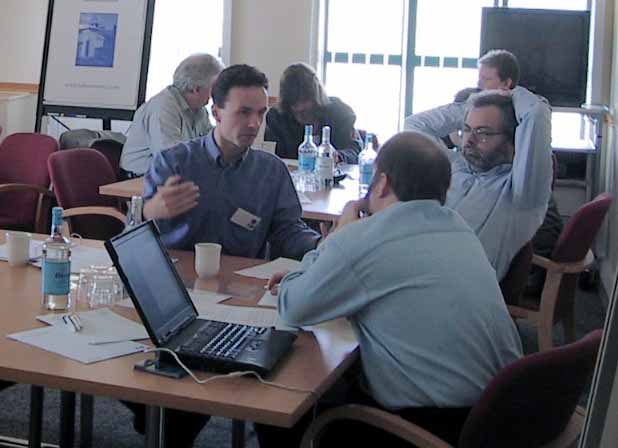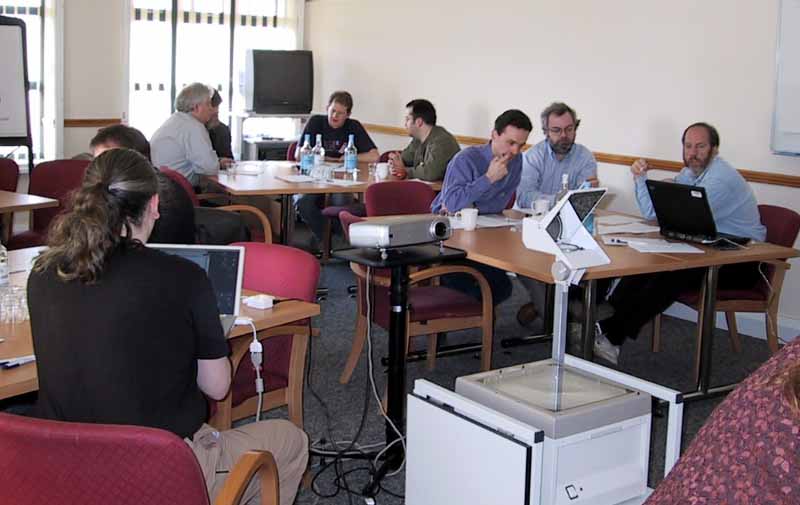DiscoveryMadeEasy
From SPA Wiki
Contents |
OT2004 Session: Easy Discovery Workshop
Summary of Session
There's also a good summary of the session on James Robertson's blog [+ 1].
The workshop began with Bernard's Power'Book playing some Jazz tracks using iTunes, and the visual effects that iTunes offers were displayed on the screen in the seminar room - the overall effect was very calming :-)
The purpose of the workshop for the presenters was to explore the issues around semantics, so Bernard began by reprising a slight variation of the beginning of the workshop abstract:
In 2001 Berners-Lee et al. presented a vision of the Semantic Web. It began thus: "The entertainment system was belting out the Beatles' "We Can Work It Out" when the phone rang. When Pete answered, his phone turned the sound down by sending a message to all the other local devices that had a volume adjuster. "
So, Bernard went over to the laptop and pressed the volume adjustment keys to increase and decrease the volume. Then John showed the audience another volume adjuster
Bernard used his Bluetooth enabled mobile phone to connect to his laptop and also adjust its volume that way. Finally, Bernard showed the audience his own volume adjuster
The point of all this was to demonstrate the need for clear semantics.
There were about 10 people in the audience, broken into three groups: one group of four people, and the remaining two groups each containing three people. The teams were set the exercise of developing a scenario that required some form of discovery service; the session was primed with four example scenarios each of which identified requirements in three categories: user, task and environment.
The teams each gave themselves a name and spent about 30 minutes working on a scenario. A summary of the scenarios follows:
Group name: Beer'Heads
“Jack Black finds himself in a strange city without local knowledge, and he could potentially find himself without alcohol long enough to sober up. The purpose of this system is to assure Jack and other folk, that no matter where they go they will never need to sober up.
Jack has a PDA. It determines where it is, what types of service are around to supply alcohol, what types of transportation services are available, local customs (should you tip, how late can you buy alcohol) and measure your money “levels.”
When Jack's blood alcohol level drops below a certain point, the PDA will not only determine the closest (or most appropriate) bar or store but will also determine the most appropriate transportation to get there.”
From the above narrative, one can determine the following requirements:
User Requirements:
Jack Black, or someone who wishes never become sober.
Task requirements:
Maintain minimum blood-alcohol level given certain constraints. Subtasks include information gathering such as
- drinking places that provide beer
- types of transportation services
- tipping etiquette
- monitoring user's blood-alcohol level
Environment requirements:
The World. A Network of places. Multiple natural languages. Connectivity variability.
Other Requirements:
Privacy, security, secrecy. Need to stay within local laws.
Group name: Edward
Intelligent Visitor-Filtering Doorbell
User Requirements:
Similar to door bell scenario.
Task Requirements
Filters visitors to house based on context and learned preferences.
- Need for discovery of context of house and home owner
- Need for discovery of purpose of visitor's visit
- Comparison of visit purpose with context with preferences, assessment of significance for the home-owner/time present.
Information requirements:
- time of day
- state of house
- who is present in house
- contents of fridge, etc.
- Learned preferences of home-owner for visitors based on context
Environment Requirements
Home.
Scenario:
: Ice-Cream vendor visiting... : Time: Sunday afternoon : Present: Kids visiting : House: fridge empty : result --> doorbell rings!
Group name: Front Left
Personal location identification cutting across devices and locations:
- Phone (land and mobile)
- PDA
- Home and other locations recognizing you and configuring themselves to your known desires
Privacy settings issues
User Requirements:
A person who has many roles and whose communication needs change based on those roles and location.
Task Requirements
If I set a role/location in any device I use it should migrate to any other device I use that would care.
As roles change, communication needs change.
Environmental requirements: Anywhere.
This exercise was followed by a brief lecture on current technologies/protocols for service/device discovery.
Following the break, the participants were then asked to consider how well the current technologies fitted with their scenarios. The technologies under consideration were restricted to the ones provided in the table. The participants were asked to answer the following questions to assess the suitability of the technologies:
1) Which technologies are inappropriate for your scenario and why?
2) Are there any scenarios that meet your needs exactly?
The participants were also asked to consider what modifications they would make to existing technologies or what new standards they would propose.
Group name: Beer'Heads
This group felt that the different technologies were appropriate for different layers of the ISO seven-layer model.
[Aside: which is:
1.Physical
2.Data Link
3.Network
4.Transport
5.Session
6.Presentation
7.Application]
For example, they felt that sensor and device discovery was down in layers 1, 2 and possibly 3, whereas service discovery was at layer 7. Thus they felt that for sensors a combination of bluetooth and OWL-S would be appropriate, combined with the use of a Web Services Architecture for layer 7. They also felt that something like sensorML would be useful for describing the capabilities of sensors at layer 1.
Group name: Edward
This group first outlined an interaction diagram involving the various devices and users in the scenario and then considered each of the columns in the table of technologies to select the ones most appropriate for their scenario.
First they deleted the Microsoft technology (UPnP) out of hand. Then they deleted the INS as it had no commercial implementation. Bluetooth was removed from the candidates as it didn't offer a leasing model or pub/sub (which the group had identified as being necessary for their solution). Similarly, OWL-S and JXTA was deleted for the same reasons, as well as Web Services. SLP was deleted as it seemed difficult to extend. Only Jini remained.
Group name: Front Left
This group selected Bluetooth mainly because their scenario fitted very well with the bluetooth model and architecture. I.e. Devices broadcast their presence to a personal area network (or at least a very localised network). However, the group considered that the Web Services architecture would probably be used for the “back-end” augmented by OWL-S to enable semantic interoperability.
And here's some photo's to prove that the participants really were working:
Back to OtTwoThousandAndFourOutput.



